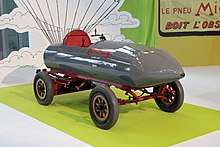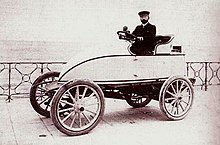La Jamais Contente
| Jenatzy | |
|---|---|

Illustration of “La Jamais Contente” with the driver and designer Camille Jenatzy |
|
| La Jamais Contente | |
| Presentation year: | 1898 |
| Vehicle fair: | |
| Class : | race car |
| Body shape : | Monoposto |
| Engine: | Electric motor |
| Production model: | none |
La Jamais Contente ( French : The Never Satisfied ) was an electrically powered speed record car that was the first road vehicle to reach speeds of more than 100 km / h. The speed record was achieved on April 29, 1899 in Achères ( Seine-et-Oise department , now in the Yvelines department ) near Paris .
Circumstances of construction

The Contente was designed and driven by the Belgian engineer and racing driver Camille Jenatzy . Jenatzy was then director of Compagnie Générale des Transports Automobiles , a company that built cars and trucks with electric drives . Jenatzy saw a challenge in the existing speed record of Gaston de Chasseloup-Laubat , who in 1898 reached a speed of 62.78 km / h with a Jeantaud Duc , which was also electrically powered . For the competition, which was advertised by the newspaper La France Automobile , he first designed the CGA Dogcart. After it came to several duels with de Chasseloup-Laubat in January and March 1899 at Achères, in which the two opponents alternately set new records, de Chasseloup-Laubat initially kept the record at a speed of 92.78 km / h. Jenatzy discarded his previous vehicle and constructed the CITA No. 25 , known under the name La Jamais Contente , an automobile designed as an electric car .
construction
The blue-gray painted body was drawn by Léon Auscher. It was stored on a box frame . The coachbuilder J. Rothschild & Fils had made them from Partinium , a light alloy of aluminum , tungsten and magnesium . The construction in the form of a torpedo was one of the first to be developed from an aerodynamic point of view. The Jenatzy concept, however, had two weaknesses: On the one hand, the driver's upper body protruded beyond the body; on the other hand, the chassis with the small, thick tires was completely exposed. Despite the streamlined body, the car offered a large surface area for the airstream. The Œuf de Pâques steam car, which took the record from the electric car in 1902, however, had a not quite as streamlined body, which nevertheless also exposed the driver and wheels to the wind.
Apart from a steering column, a handbrake and a foot lever that could be used to regulate the acceleration , the vehicle had no other controls. Two 25 kW electric motors from the French engineer André Étienne Postel-Vinay, which worked with 200 volts and 125 amps , drove the car. The electricity was stored in a lead-acid battery consisting of 82 fr: Fulmen elements . The French manufacturer Société de l'accumulateur Fulmen from Clichy offered the highest storage capacity at the time with its Fulmen B 17 . An accumulator element weighed 10.4 kg at a capacity of 135 ampere-hours and a discharge current of 27 A. On red wheels were 65 mm thick pneumatic tire of Michelin mounted.
record
From 1898 the Concours de Vitesse (speed competitions) were held on the two-kilometer route near Achères . The route was divided into two halves, the first kilometer for acceleration from a standing start, the second half for a flying start. Three groups of timekeepers with stopwatches (accuracy 0.2 seconds) and signal flags took care of the measurements. After a failed attempt on March 31, 1899, Jenatzy drove the 1450 kg vehicle through the kilometer on April 29, 1899 with a flying start in exactly 34 seconds. This meant a top speed of 105.882 km / h. He exceeded the record of his opponent de Chasseloup-Laubat and was the first record holder to exceed the 100 km / h mark. The record was lost when Léon Serpollet drove the egg-shaped Oeuf de Pâques (Easter egg) steam car on April 13, 1902. Serpollet reached a speed of 120.80 km / h and was the first driver of a non-electrically powered vehicle to break the speed record for land vehicles.
Whereabouts
The record car was used as a test car by the tire manufacturer Michelin from July 1899 . After numerous exhibitions, the car was brought to the Musées du Château in Compiègne in 1931 . The car on display today is, however, a replica.
Remarks
- ↑ In French , cars are always female , see e.g. B. here ; It is called une Peugeot , une Mercedes , etc. French magazines rumored that the name can be traced back to Jenatzy's wife.
Web links
Individual evidence
- ↑ a b Hans-Hermann Braess, Ulrich Seiffert 2007: Automobildesign und Technik , Vieweg + Teubner Verlag, ISBN 978-3-8348-9411-3 , p. 7
- ↑ a b c Ferdinand CW Käsmann: World record vehicles . Schwarzkopf & Schwarzkopf Verlag, Berlin 2003, ISBN 3-89602-527-9 , p. 16 ff
- ↑ a b c d Peter Borscheid 2004: Das Tempo-Virus Campus Verlag, ISBN 3-593-37488-9 , p. 205
- ↑ La Jamais Contente Charactéristiques techniques. (PDF) In: e-mobiles.ch. Archived from the original on December 18, 2010 ; accessed on November 4, 2018 (French).
- ↑ H. Bachner: The common automotive systems. In: Polytechnisches Journal . 315, 1900, pp. 239-242.


